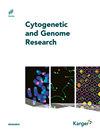Whole-Exome Sequencing Targeting a Gene Panel for Sensorineural Hearing Loss: The First Portuguese Cohort Study
IF 1.7
4区 生物学
Q4 CELL BIOLOGY
引用次数: 0
Abstract
Next-generation sequencing (NGS) technologies revolutionized the molecular diagnosis of sensorineural hearing loss (SNHL) and are now a standard of care. In this study, 71 Portuguese probands with hereditary SNHL were assessed by whole-exome sequencing (WES) targeting a panel of 158 genes related to SNHL, aiming to evaluate the diagnostic yield of this methodological approach and to report the spectrum of variants. Patients with either nonsyndromic or syndromic SNHL were included. Also, patients were previously screened for variants in the GJB2 gene and for duplications/deletions in the GJB6 gene. Causative variants in 11 different genes were identified in 15 (21.1%) out of 71 probands, 5 of which had associated syndromes. In 6 other patients (8.5%), presumptive causative variants were identified in MYO15A, TMIE, TBC1D24, SPMX, GJB3, PCDH15, and CDH23 genes, uncovering a potential case of digenic Usher syndrome. The study was inconclusive in 20 probands (28.2%), in 19 due to lack of segregation analysis and in one due to uncertain phenotype-genotype matching. In the remaining 30 patients (42.3%) no potentially causative variants were identified. The diagnostic yield did not significantly vary according to the age of hearing-impairment onset. As the first study on the application of NGS technologies in SNHL based on a Portuguese cohort, our results may contribute to characterize the spectrum of variants related to SNHL in the Portuguese population. Additionally, the present study provides new insights into the contribution of MYO3A, TECTA, EDNRB, TBC1D24, and GJB3 genes to SNHL. For the significant number of undiagnosed patients, reanalysis of WES data – either for a broader gene panel or in a non-targeted approach – may be considered.针对感觉神经性听力损失基因组的全外显子组测序:第一项葡萄牙队列研究
下一代测序(NGS)技术彻底改变了感音神经性听力损失(SNHL)的分子诊断,现在已成为一种标准的治疗方法。在这项研究中,71名患有遗传性SNHL的葡萄牙先证者通过针对158个与SNHL相关的基因的全外显子组测序(WES)进行了评估,旨在评估这种方法的诊断效果并报告变异谱。包括非综合征或综合征性SNHL患者。此外,之前对患者进行了GJB2基因变异和GJB6基因重复/缺失的筛查。在71名先证者中,有15人(21.1%)发现了11个不同基因的因果变异,其中5人患有相关综合征。在其他6名患者(8.5%)中,在MYO15A、TMIE、TBC1D24、SPMX、GJB3、PCDH15和CDH23基因中发现了推定致病变异,揭示了一个潜在的双基因Usher综合征病例。该研究在20名先证者(28.2%)中没有结论,其中19名由于缺乏分离分析,1名由于表型-基因型匹配不确定。在剩下的30名患者(42.3%)中,没有发现潜在的致病变异。根据听力损伤的发病年龄,诊断率没有显著差异。作为第一项基于葡萄牙队列的NGS技术在SNHL中应用的研究,我们的结果可能有助于表征葡萄牙人群中与SNHL相关的变异谱。此外,本研究为MYO3A、TECTA、EDNRB、TBC1D24和GJB3基因对SNHL的贡献提供了新的见解。对于大量未确诊的患者,可以考虑对WES数据进行重新分析——无论是针对更广泛的基因组还是非靶向方法。
本文章由计算机程序翻译,如有差异,请以英文原文为准。
求助全文
约1分钟内获得全文
求助全文
来源期刊

Cytogenetic and Genome Research
生物-细胞生物学
CiteScore
3.10
自引率
5.90%
发文量
25
审稿时长
1 months
期刊介绍:
During the last decades, ''Cytogenetic and Genome Research'' has been the leading forum for original reports and reviews in human and animal cytogenetics, including molecular, clinical and comparative cytogenetics. In recent years, most of its papers have centered on genome research, including gene cloning and sequencing, gene mapping, gene regulation and expression, cancer genetics, comparative genetics, gene linkage and related areas. The journal also publishes key papers on chromosome aberrations in somatic, meiotic and malignant cells. Its scope has expanded to include studies on invertebrate and plant cytogenetics and genomics. Also featured are the vast majority of the reports of the International Workshops on Human Chromosome Mapping, the reports of international human and animal chromosome nomenclature committees, and proceedings of the American and European cytogenetic conferences and other events. In addition to regular issues, the journal has been publishing since 2002 a series of topical issues on a broad variety of themes from cytogenetic and genome research.
 求助内容:
求助内容: 应助结果提醒方式:
应助结果提醒方式:


